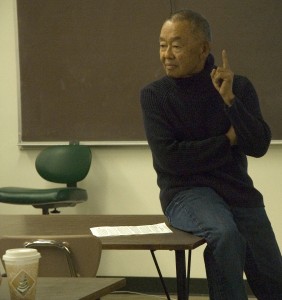A fourth edition of “Japanese Americans and World War II: Mass Removal, Imprisonment, and Redress” (with Dr. Nadine Ishitani Hata; Wheeling, Ill.; Harlan Davidson, 2010) has recently been published by Dr. Don Hata, emeritus professor of history. The introductory summary of the subject, which evolved from a 33-page essay, was originally written in 1974 by Hata and his late wife, who taught history at California State University, Dominguez Hills before becoming a professor of history and emeritus vice president of Academic Affairs at El Camino College.

On Dec. 16, Don Hata visited the Albany Civil Rights Institute in Albany, Ga. for a book signing and presented a talk on the incarceration of Japanese Americans during WWII. He says that there are strong parallels between the Civil Rights movement and the efforts of Japanese Americans to gain redress after their imprisonment.
“It was a fitting place for me to speak on this subject, because Japanese Americans were conspicuous by their absence in documentaries and news stories of civil rights marches and brutal confrontations with… agents of an explicitly racist society,” says Hata.
Hata says that the older generations of Nikkei (Japanese-born American citizens) and Nisei (American-born citizens of Japanese descent) who were imprisoned returned to their broken lives after the war and attempted to put the camp experience aside.
“Nadine and I described to our students the psychological castration, denial, and craven cowardice [that] characterized the self-styled leadership of the Japanese American community during the decades after World War II,” says Hata. “Thus we played no significant role in the civil rights movement which, ironically, paved the way a half- century later for the Japanese American Redress Movement.”
However, the offspring of the incarcerated Japanese Americans persisted in asking questions and learning the story of the camps, which spawned a 17- year movement for redress that lasted through three presidential administrations. President Gerald Ford terminated Executive Order 9066 in 1976. In 1988, President Ronald Reagan signed a Civil Liberties Act that offered Japanese Americans an official apology from the U.S. government and one-time, non-taxable cash reparations of $20,000, the delivery of which did not occur until 1993 when a letter of apology to survivors of the incarceration, along with the promised monetary compensation was finally sent by President Bill Clinton.
Hata says however, that the story is not finished, with justice forestalled in the WWII cases of four Japanese American citizens whose civil rights were violated by curfews and Executive Order 9066, which ordered them to leave their homes and businesses and be taken to the incarceration camps.
“This is still an unfinished story, with scant influence on the further erosion of civil rights in the wake of 9-11… and the refusal of nine political appointees to the U.S. Supreme Court to agree to a full review of the civil rights violations of U.S. citizens in the so-called Japanese American wartime cases of Fred Korematsu, Gordon Hirabayashi, Minoru Yasui, and Mitsuye Endo,” says Hata. “It is time to think about going beyond the politically partisan Supremes and seek a full public accounting before an international war crimes tribunal.”
Last August, Hata and artist Mary Higuchi spoke on “Kids in the Nikkei Gulag-Diaspora,” sharing recollections of their childhoods in the camps at the Manzanar National Historic Site Interpretive Center in Independence, Calif. Higuchi, an accomplished South Bay artist whose work tells the story of her experiences during WWII, provided the cover art for the fourth edition of “Japanese Americans and World War II: Mass Removal, Imprisonment, and Redress.”
Dr. Nadine Hata served two terms on the California State Historical Resources Commission when the concentration camps at Manzanar and Tule Lake were designated as historic sites. A native of Honolulu, Hawaii, she died in 2005 of metastasized breast cancer. Don Hata has served as planning commissioner and city councilman of the city of Gardena and elected to the Nominations Committee of the California Historical Society and Historical Society of Southern California, and the American Historical Association. He was born in 1939 in East Los Angeles and incarcerated at age three at Gila River, Ariz. during World War II.
For more information on the history department at CSU Dominguez Hills, click here.